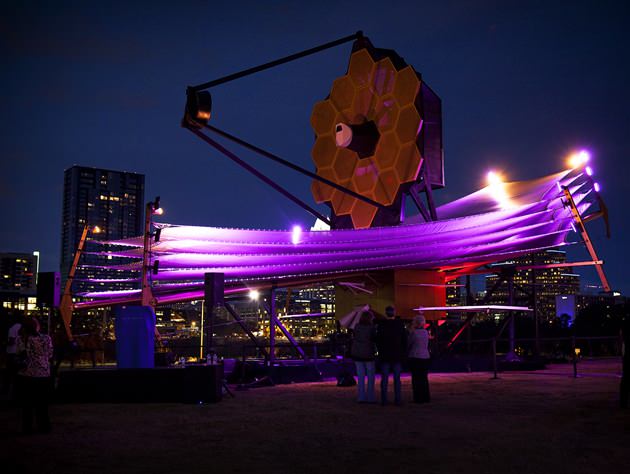Five amazing facts about the big telescope that comes after Hubble
By Phoebe Connelly | SXSW – 9 hours ago

SXSW Interactive may be a conference concerned with online space, but NASA took the gathering of geeks as an opportunity to showcase a tool concerned with revealing the mysteries of outer space.
On the front lawn of the Long Center for the Performing Arts in downtown Austin, NASA set up a to-scale model of the James Webb Space Telescope (JWST) as well as a fully staffed information center. The telescope is named for the second administrator of NASA, James E. Webb, who oversaw the first manned missions to space. Scheduled to launch in 2018, the JWST is the successor to the Hubble space telescope, which has been in orbit since 1990.
"The mission is primarily to see the first light created after the Big Bang," says Scott Willoughby, the Program Manager for JWST at Northrop Grumman. "That light is very far back in the distance; and you see farther back in time the farther away you look.
"We're seeing further back, because [JWST] is more sensitive. But we are also seeing things we couldn't see because we're looking at a different part of the spectrum—infrared."
Here are five of the coolest things we found out about the largest-ever telescope built by NASA:
1. Each of the telescope's mirrors is coated with the equivalent of eight gold wedding rings.
The Webb telescope has 21 mirrors with which to capture information about the universe. The mirrors are constructed of beryllium, and then coated with an extremely thin layer of gold—as one JWST rep estimated, around that of eight wedding rings. The primary mirror spread, which is made up of 18 hexagon-shaped mirrors, is 6.5 meters long—almost three times the size of Hubble's 2.4-meter mirror. That extra size adds up to greater light gathering ability, which in turn, means more precise and detailed images.
2. We'll get a better picture of what really young galaxies look like.
The key innovation with JWST is its ability to capture light on the infrared spectrum. This will allow the telescope to "see" through dust clouds, and get more information about distant galaxies. Because of the distance, we’re looking at these galaxies at a young age. Webb will serve as a "cosmic time machine," in that sense, says Dr. James Bullock, of the University of California Irvine.
The images we already have of these distant galaxies show formations with an almost "ratty" appearance. These "galaxies in adolescence" may no longer exist in these same forms by the time the light that Webb will be able to pick up reaches the telescope.
3. The man who helped establish the Big Bang theory is building it.
Dr. John Mather is one of the key scientists on the Webb project. He was awarded the Nobel Prize in 2006 for his work in establishing the Big Bang theory. Mather delivered several talks in Austin about his work on JWST, and what he hopes it will accomplish. Context, he said, is the most important.
"Our job as modern scientists," Mather told the crowd on Saturday, "is to work out the details."
4. It's folded up because otherwise there wouldn't be a rocket large enough to launch it.
Mather's biggest concern with Webb is how it will unfold once it is launched into space. The telescope is roughly the size of a Boeing 737, and it will be folded up so that it can fit into the rocket. It is, Mather said, "a kind of origami telescope."
Once in space, Webb will unfold into its operational configuration over the course of a week. Getting the telescope unfurled once it is launched is “the scary thing about the project," Mather said.
5. You can watch it being built.
Forget puppy cams, why not point your browser over to the live cam NASA has set up at Goddard Space Flight Center in Greenbelt, Md., where Webb is being assembled? The team behind the JWST has given the public a window into the assembly of NASA’s latest groundbreaking scientific instrument that is much like the video feed that scientists at the Jet Propulsion Laboratory in Southern California set up so the public could watch Curiosity being built.

No comments:
Post a Comment